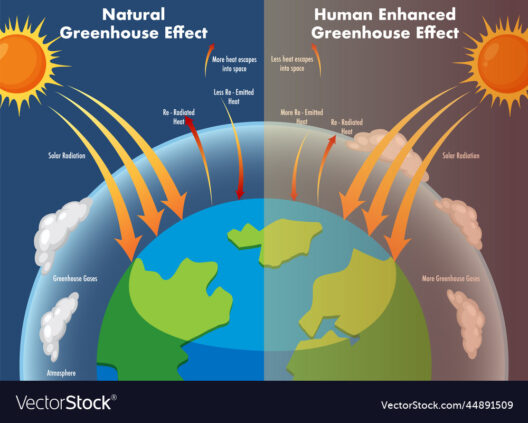How does the beef on your plate contribute to the rising global temperatures? As the public becomes more conscious of the environmental ramifications of our dietary choices, the relationship between livestock farming and climate change comes into sharper focus. This connection prompts an essential and perhaps playful question: If cows could talk, would they plea for less beef on our plates, or perhaps advocate for more sustainable practices in how we farm them? The reality is multifaceted and complex, encompassing agricultural practices, methane emissions, and the sustainability of our food systems.
The livestock sector is a significant contributor to climate change, responsible for approximately 14.5% of all human-induced greenhouse gas emissions. This figure does not merely include carbon dioxide; it encompasses a variety of gases, namely methane and nitrous oxide, which are considerably more potent in terms of their heat-trapping capabilities. Livestock, particularly cattle, emit methane during digestion through a process called enteric fermentation. This gas is approximately 28 times more effective than carbon dioxide at capturing heat over a 100-year period. Thus, the farming of livestock is not just an agricultural issue—it is a pressing climate concern.
Moreover, the land used for livestock grazing and feed production contributes to deforestation and habitat loss. The expansion of pastures and feed crops like soybeans necessitates the clearing of vast forms of forest, releasing stored carbon into the atmosphere and diminishing our planet’s ability to sequester this essential gas. In regions like the Amazon Rainforest, cattle ranching is a primary driver of deforestation. Such practices not only exacerbate climate change but also threaten biodiversity. The planet’s ecosystems are intricately linked, and the loss of species can lead to irreversible consequences for ecological health.
It is imperative to consider the water footprint associated with livestock farming as well. The production of animal-based foods generally requires more water than plant-based alternatives. For example, it is estimated that producing just one pound of beef requires approximately 1,800 gallons of water. This staggering figure encompasses the water needed for drinking, animal feed, and processing. In contrast, plant-based foods, such as legumes and grains, typically require significantly less water. As global water scarcity becomes more pressing due to population growth and climate change, the inefficiency of animal agriculture becomes a critical element of discussion.
As the conversation around livestock farming continues to burgeon, it illuminates a pedestrian yet vital question: What can we eat instead? A shift towards plant-based diets is not only health-promoting but also sustains our environment. Foods like lentils, beans, chickpeas, grains, and a variety of fruits and vegetables provide ample nutrition and have a lower carbon footprint than their animal-based counterparts. This provides consumers with the opportunity to advocate for sustainable food systems while simultaneously attending to personal health.
Transitioning to a more plant-centered diet can have broad-reaching impacts. Research indicates that if more individuals adopted a plant-based diet, we could significantly reduce greenhouse gas emissions and free up land previously used for livestock. This shift could allow for reforestation efforts in degraded areas, helping to restore ecosystems and enhance biodiversity. Furthermore, diverse agricultural practices that include crop rotation and polyculture farming could be encouraged, increasing resilience against climate change and enhancing soil health.
However, transitioning diets is not merely a personal choice; it requires societal evolution. Consumer demand has a tangible effect on agricultural practices. By prioritizing plant-based foods and sustainably sourced options, individuals can spur businesses and farmers to re-evaluate production methods. This community-driven approach could engender a culture of sustainable consumption that resonates through local economies and agriculture suppliers.
Educational initiatives are vital in these transformations. Awareness campaigns focusing on the environmental impact of animal agriculture can foster a more informed public. Schools, community centers, and various organizations can play pivotal roles in disseminating this knowledge, encouraging individuals to explore plant-based diets without compromising enjoyment or satisfaction. Culinary workshops highlighting the versatility of legumes, grains, and vegetables can also serve to inspire families to embrace these dietary shifts.
Despite the progress possible in adopting plant-based diets, the challenge remains rooted in cultural and economic systems. For many, dietary habits are deeply entrenched, and the allure of traditional meat-based meals may be difficult to overcome. Moreover, access to fresh produce can be limited in certain communities, often referred to as “food deserts,” where healthy food options are scarce. Thus, it becomes essential to advocate for policies that promote equitable access to nutritious and sustainable foods, ensuring that the transition towards sustainable agriculture does not disproportionately affect marginalized communities.
In conclusion, the impact of livestock farming on climate change is profound and multifaceted. By embracing a more plant-based diet, individuals can make a tangible difference, both environmentally and personally. The role of education and community in fostering these changes cannot be underestimated. As we ponder the question of what we should eat instead, the challenge lies not only in our food choices but also in our commitment to creating a sustainable world. Ultimately, it is our collective responsibility to ensure that our dietary habits reflect our values regarding climate, health, and sustainability.




